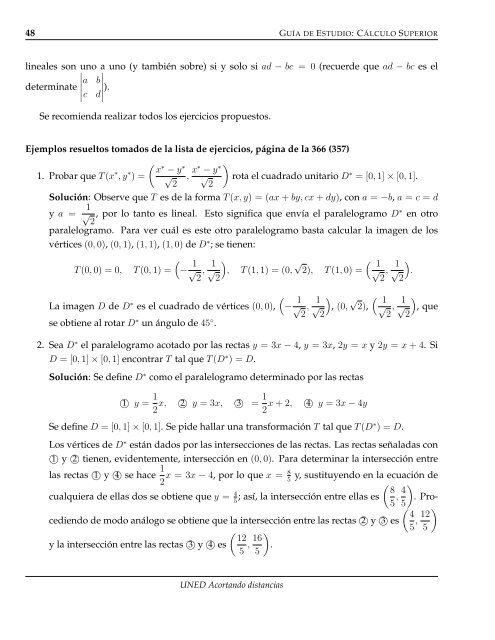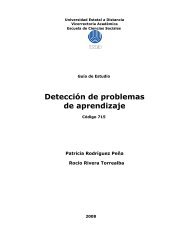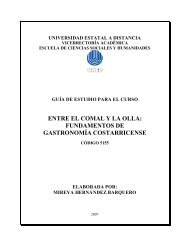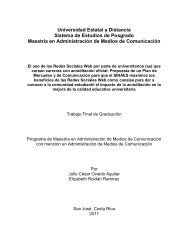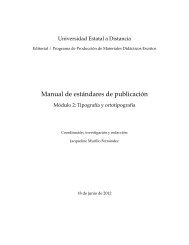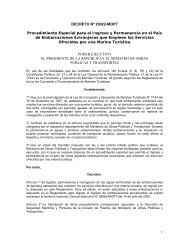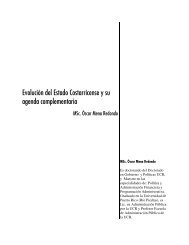GE3011 Cálculo Superior - Repositorio de la Universidad Estatal a ...
GE3011 Cálculo Superior - Repositorio de la Universidad Estatal a ...
GE3011 Cálculo Superior - Repositorio de la Universidad Estatal a ...
You also want an ePaper? Increase the reach of your titles
YUMPU automatically turns print PDFs into web optimized ePapers that Google loves.
48 GUÍA DE ESTUDIO: CÁLCULO SUPERIOR<br />
lineales son uno<br />
a uno (y también sobre) si y solo si ad − bc = 0 (recuer<strong>de</strong> que ad − bc es el<br />
<br />
a<br />
b<br />
<br />
<br />
<strong>de</strong>terminate <br />
c<br />
d<br />
).<br />
Se recomienda realizar todos los ejercicios propuestos.<br />
Ejemplos resueltos tomados <strong>de</strong> <strong>la</strong> lista <strong>de</strong> ejercicios, página <strong>de</strong> <strong>la</strong> 366 (357)<br />
1. Probar que T (x ∗ , y ∗ ∗ ∗ x − y<br />
) = √ ,<br />
2 x∗ − y∗ <br />
√ rota el cuadrado unitario D<br />
2<br />
∗ = [0, 1] × [0, 1].<br />
Solución: Observe que T es <strong>de</strong> <strong>la</strong> forma T (x, y) = (ax + by, cx + dy), con a = −b, a = c = d<br />
y a = 1<br />
√ , por lo tanto es lineal. Esto significa que envía el paralelogramo D<br />
2 ∗ en otro<br />
paralelogramo. Para ver cuál es este otro paralelogramo basta calcu<strong>la</strong>r <strong>la</strong> imagen <strong>de</strong> los<br />
vértices (0, 0), (0, 1), (1, 1), (1, 0) <strong>de</strong> D ∗ ; se tienen:<br />
T (0, 0) = 0, T (0, 1) =<br />
La imagen D <strong>de</strong> D ∗ es el cuadrado <strong>de</strong> vértices (0, 0),<br />
se obtiene al rotar D ∗ un ángulo <strong>de</strong> 45 ◦ .<br />
<br />
− 1<br />
√ ,<br />
2 1<br />
<br />
√ , T (1, 1) = (0,<br />
2<br />
√ <br />
1<br />
2), T (1, 0) = √2 , 1<br />
<br />
√ .<br />
2<br />
<br />
− 1<br />
√ ,<br />
2 1<br />
<br />
√ , (0,<br />
2<br />
√ <br />
1<br />
2), √2 , 1<br />
<br />
√ , que<br />
2<br />
2. Sea D ∗ el paralelogramo acotado por <strong>la</strong>s rectas y = 3x − 4, y = 3x, 2y = x y 2y = x + 4. Si<br />
D = [0, 1] × [0, 1] encontrar T tal que T (D ∗ ) = D.<br />
Solución: Se <strong>de</strong>fine D ∗ como el paralelogramo <strong>de</strong>terminado por <strong>la</strong>s rectas<br />
1○ y = 1<br />
1<br />
x, 2○ y = 3x, 3○ = x + 2, 4○ y = 3x − 4y<br />
2 2<br />
Se <strong>de</strong>fine D = [0, 1] × [0, 1]. Se pi<strong>de</strong> hal<strong>la</strong>r una transformación T tal que T (D ∗ ) = D.<br />
Los vértices <strong>de</strong> D ∗ están dados por <strong>la</strong>s intersecciones <strong>de</strong> <strong>la</strong>s rectas. Las rectas seña<strong>la</strong>das con<br />
1○ y 2○ tienen, evi<strong>de</strong>ntemente, intersección en (0, 0). Para <strong>de</strong>terminar <strong>la</strong> intersección entre<br />
<strong>la</strong>s rectas 1○ y 4○ se hace 1<br />
8<br />
x = 3x − 4, por lo que x = y, sustituyendo en <strong>la</strong> ecuación <strong>de</strong><br />
5 2<br />
cualquiera <strong>de</strong> el<strong>la</strong>s dos se obtiene que y = 4<br />
<br />
8 4<br />
; así, <strong>la</strong> intersección entre el<strong>la</strong>s es , . Pro-<br />
5 5 5<br />
<br />
4 12<br />
cediendo <strong>de</strong> modo análogo se obtiene que <strong>la</strong> intersección entre <strong>la</strong>s rectas 2○ y 3○ es ,<br />
5 5<br />
y <strong>la</strong> intersección entre <strong>la</strong>s rectas 3○ y 4○ es<br />
<br />
12 16<br />
,<br />
5 5<br />
<br />
.<br />
UNED Acortando distancias


